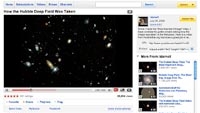As Web video use expands, so too does the length of programming

In the 1890s, the first kinetoscopes ran film clips about 30 seconds long, mainly because of the technical limitations caused by extraordinarily long strips of film. A hundred years later, with the first crude video on the Internet, clips were also very short — mainly because of slow personal computers and even slower Internet connections.
Now, that has changed. As video continues its rapid migration to the Internet, image and sound quality has dramatically improved, and programming is getting longer. Attribute this to faster personal computers, high-speed broadband Internet connections, better compression technology and, perhaps most of all, the influence of commercial television as it transitions its programming online.
The Internet is rapidly becoming a huge video jukebox — housing everything from short clips to full-length feature films that can be watched on-demand using a wide range of devices from any location. The short videos of YouTube 1.0 — with its myriad of cute babies and performing cats and dogs — have been replaced by a new generation of more sophisticated programming.
Just for Internet viewing, production companies are now creating 10- and 20-minute videos and writing more complex stories for their characters. Some are now competing with the traditional television networks by introducing new shows this month, aware that the networks are showing summer repeats.
One of the turning points in the networks transition to the Internet began with the establishment of Hulu, which launched publicly on March 12, 2008. It carries the programs of several networks and cable channels. An estimated one in four Internet viewers now watches the Hulu service, which uses Adobe’s Flash technology.
The expanded online viewer attention spans have surprised many producers. ComScore, the measurement firm, found that 150 million Internet users in the United States watch about 14.5 billion videos each month. That’s an average of 97 videos per viewer. The length of clips is also expanding, said the company, to an average of 3.4 minutes as of last March.
The shift to longer programming has influenced YouTube, the Internet’s dominant video provider. The Web site recently added a “Shows” tab to its interface, directing its users to long-form video and feature-length films.
The professional video industry's #1 source for news, trends and product and tech information. Sign up below.
Web video continues its explosive growth — now threatening both over-the-air viewing and pay-TV providers. The research firm eMarketer estimates it will become a $1 billion business by 2011.
Empowered by low-cost production and editing equipment and virtually no distribution costs, the Web is opening to the door to a new generation of video producers. Not only is no subject too narrow or off limits for the Web, but the programming can be produced to the optimum length to fit the content. The constraints of a network or television schedule no longer matter. In this new medium, storytelling becomes more important than the stopwatch.
The trend has pay television, especially cable providers, running scared. In this poor economy, increasing numbers of cable subscribers are turning off cable service and its $100-a-month-plus bills in favor of watching free Internet fare. Because of this, cable providers are scrambling to protect their premium content.
Ideas include special serial numbers that cable subscribers can use to access premium programming on the Web. However, cable executives have warned that the technical and business challenges to protect its business are daunting.
“HBO Go,” a new Internet component to the premium network only for subscribers to the television service, was just revealed this spring and is now in the experimental stages. Rather than use serial numbers, subscribers access “HBO Go” through their cable provider’s Web site. From there, they will be able to view movies and series and set up their own watch lists.
